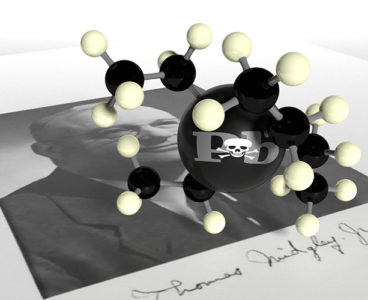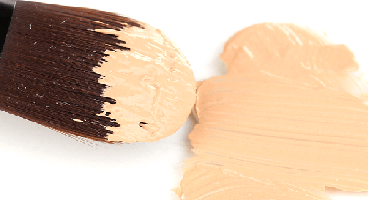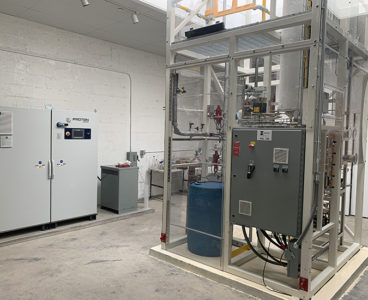By Mark Jones A century is how long it took for one bad chemistry choice to run its course. The end of August 2021 was the end of what can only be described as a sad century in the history of chemistry. At the end of August, headlines proclaimed the world finally stopped using leaded…
Argonne to host webinar on achieving net-zero carbon emissions in manufacturing
Argonne National Laboratory scientists will host Frontiers in Materials Manufacturing: Decarbonizing Industry Through Electrochemical Processing, 10 a.m. to 12:45 p.m. CST on Thursday, October 21, 2021 Achieving net-zero carbon emissions by 2050 will require new approaches to chemicals and materials manufacturing, whose two sources of emissions — direct emissions from fossil feedstocks used in the…
First net zero mass spectrometer launched to support greener future
The launch of the world’s first net zero mass spectrometer (MS) will make it easier than ever for scientists working across geoscience, food and beverage, environmental science and forensics to practice science sustainably. The Thermo Scientific Delta Q Isotope Ratio Mass Spectrometer (IRMS) is a next generation gas IRMS designed to enable detailed analysis with…
Catalyst study advances carbon-dioxide-to-ethanol conversion
From Brookhaven National Laboratory An international collaboration of scientists has taken a significant step toward the realization of a nearly “green” zero-net-carbon technology that will efficiently convert carbon dioxide, a major greenhouse gas and hydrogen into ethanol, which is useful as a fuel and has many other chemical applications. The study reports a “roadmap” for…
Eco-friendly SOLESPHERE silica gels improve tactile aesthetics in skincare formulations
To help formulators develop high-performance, safer cosmetics and skin care products, AGC Chemicals Americas offers SOLESPHERE microsphere silica gels. When used in sunscreens, cosmetics and skincare formulations, the silica gels boost sun protection factor (SPF) and add performance properties. The silica gels can improve application smoothness, absorb oil and perspiration, give a matte appearance, minimize…
Vistafolia to drive sustainability in sector through University of Surrey KTP
Creator and supplier of realistic artificial green walls, Vistafolia, has launched a collaboration with the University of Surrey to create a new base polymer, the material that their artificial plants are made from, using renewable sources, while maintaining the established safety and design standards of its original product. Co-funded by Innovate U.K., as part of…
DOE announces $37M to small businesses for climate, energy and scientific R&D
In support of the Biden-Harris Administration’s commitment to build the American economy back better, the U.S. Department of Energy (DOE) announced a plan to provide $37 million for small businesses pursuing climate and energy research and development (R&D) projects as well the development of advanced scientific instrumentation through a funding opportunity announcement (FOA). The projects…
Researchers demonstrate technique for recycling nanowires in electronics
By Yong Zhu and Matt Shipman, North Carolina State University Researchers at North Carolina State University demonstrated a low-cost technique for retrieving nanowires from electronic devices that have reached the end of their utility and then using those nanowires in new devices. The work is a step toward more sustainable electronics. “There is a lot…
Why your glassware washer is a key ingredient for a more sustainable lab
Labs are one of the most resource-intensive spaces in any industry. Wherever possible scientists should aim to conserve resources, save energy and reduce emissions, thus, it comes as no surprise that there is a great opportunity to reduce the environmental impact of labs through smarter purchases. Miele and SelectScience are offering a webinar on Friday,…
Nagoya Institute of Technology and NGK form “NGK Environment Innovation Laboratory”
Nagoya Institute of Technology (NITech) and NGK INSULATORS (NGK), both based in Nagoya, Japan, have established the NGK Environment Innovation Laboratory on the NITech campus. This collaboration between the private sector and academia will work on creating innovative next-generation products that contribute to a significant reduction of greenhouse gases, such as materials for next-generation power…
3D-printed air: a cool solution to help tackle global warming
BVN Architecture and the University of Technology Sydney (UTS), Australia, have teamed up to design the world’s first robotically 3D-printed air-diffusion system, called ‘Systems Reef 2’ (SR2). SR2 reinvents air distribution: replacing steel with recycled plastic, square corners with aerodynamic curves and large vents with fine pores. The building sector is responsible for nearly 40%…
Key to carbon-free cars? Look to the stars
By Theresa Duque, Berkeley Laboratory For nearly half a century, astrophysicists and organic chemists have been on the hunt for the origins of C6H6, the benzene ring – an elegant, hexagonal molecule comprised of 6 carbon and 6 hydrogen atoms. Astrophysicists say that the benzene ring could be the fundamental building block of polycylic aromatic…
Here comes the sun: Tethered-balloon tests ensure safety of new solar-power technology
By Mollie Rappe, Sandia News Media What do tiny dust particles, 22-ft-wide red balloons and “concentrated” sunlight have in common? Researchers from Sandia National Laboratories recently used 22-ft-wide tethered balloons to collect samples of airborne dust particles to ensure the safety of an emerging solar-power technology. The study determined that the dust created by the…
To design truly compostable plastic, scientists take cues from nature
By Theresa Duque Despite our efforts to sort and recycle, less than 9% of plastic gets recycled in the U.S., and most ends up in landfill or the environment. Biodegradable plastic bags and containers could help, but if they’re not properly sorted, they can contaminate otherwise recyclable #1 and #2 plastics. What’s worse, most biodegradable…
With this new science, plastics could see a second life as biodegradable surfactants
By Laura Millsaps Scientists at the Institute for Cooperative Upcycling of Plastics (iCOUP), an Energy Frontier Research Center led by Ames Laboratory, have discovered a chemical process that provides biodegradable, valuable chemicals, which are used as surfactants and detergents in a range of applications, from discarded plastics. The process has the potential to create more…
DOE announces $61.4M for biofuels research to reduce transportation emissions
The U.S. Department of Energy (DOE) today announced $61.4 million for technologies that produce low-cost, low-carbon biofuels. Biofuels are derived from renewable resources and can power heavy-duty vehicles that are difficult to electrify with current technologies — including airplanes and ships — to help accelerate America’s path to a net-zero emissions economy by 2050. “Biofuels are…
Tires turned into graphene that makes stronger concrete
By Mike Williams This could be where the rubber truly hits the road. Rice University scientists have optimized a process to convert waste from rubber tires into graphene that can, in turn, be used to strengthen concrete. The environmental benefits of adding graphene to concrete are clear, chemist James Tour said. “Concrete is the most-produced…
Pluton Biosciences signs research agreement with Bayer AG to investigate microbial-based carbon capture product
Pluton Biosciences has signed a research agreement with global life sciences company Bayer AG to investigate the development of an all-natural, microbial-based carbon-capture soil amendment for growers. Collaborating with Bayer’s Climate Change Group, Pluton will use its Micromining Innovation Engine to identify and develop microbes currently found in soil that can store carbon and nitrogen.…
MilliporeSigma enhances Design for Sustainability framework, offers customers data-driven insights for greener solutions
MilliporeSigma has launched an enhanced Design for Sustainability (DfS) framework, a unique approach to holistically integrate sustainability into products, systems and services. With the introduction of DfS, MilliporeSigma leads the life science industry in ensuring that sustainability is at the forefront of each stage of the product life cycle. This important strategic initiative supports the…
Department of Energy to invest $25M in polymer upcyling, plastic waste reuse research
From the office of the U.S. Department of Energy (DOE) The U.S. Department of Energy (DOE) this week announced plans to invest $25 mil in fundamental science to lay the groundwork for technology that finds reuses for plastic waste, makes strides toward addressing the global plastic waste crisis and reduces the climate impacts of plastic…
Getting to net zero – and even net negative – is surprisingly feasible, and affordable
By Julie Chao Reaching zero net emissions of carbon dioxide from energy and industry by 2050 can be accomplished by rebuilding U.S. energy infrastructure to run primarily on renewable energy, at a net cost of about $1 per person per day, according to new research published by the Department of Energy’s Lawrence Berkeley National Laboratory…
Concept for a hybrid-electric plane may reduce aviation’s air pollution problem
By Jennifer Chu | MIT News Office At cruising altitude, airplanes emit a steady stream of nitrogen oxides into the atmosphere, where the chemicals can linger to produce ozone and fine particulates. Nitrogen oxides, or NOx, are a major source of air pollution and have been associated with asthma, respiratory disease, and cardiovascular disorders.…
R&D 100 winner of the day: Air Co. Carbon Dioxide Conversion to Ethanol
Air Co.’s technology and integrated process helps to combat anthropogenic climate change by transforming carbon dioxide and water into ethanol and oxygen, driven solely by renewable electricity. Climate change is exacerbated by our reliance on burning fossil fuels, which releases carbon dioxide into the atmosphere. Plants continue to sequester carbon dioxide via photosynthesis, but we…
Panning for gold: searching for new materials in the age of sustainability
By Chris Cogswell, customer consultant and Kane Gu, product manager Elsevier When it comes to the materials we use in industry and daily life, we’re facing a range of new challenges — from shortages to environmental issues, to the need for new materials to support technology innovation. On top of this, consumer awareness is on…
‘Sparkling’ clean water from nanodiamond-embedded membrane filters
ACS Applied Materials & Interfaces Although most of the planet is covered by water, only a fraction of it is clean enough for humans to use. Therefore, it is important to recycle this resource whenever possible. Current purification techniques cannot adequately handle the very hot wastewater generated by some industries. But now, researchers reporting in…

























